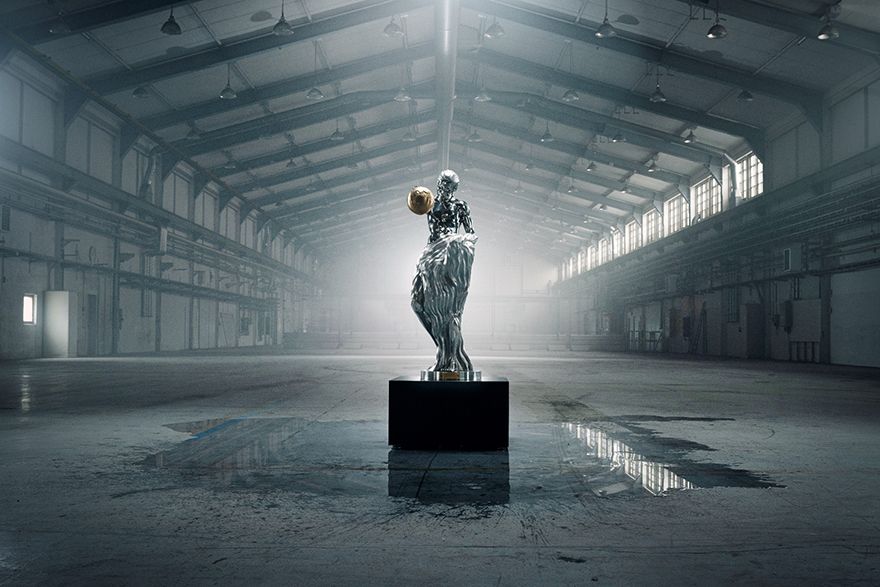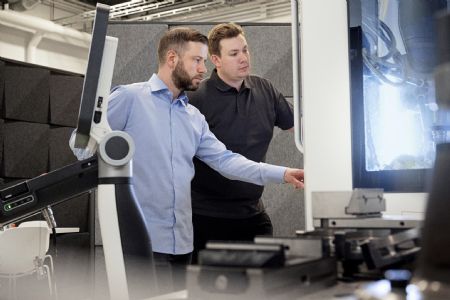 Impossible Statue
Impossible StatueCrafting works of art from metal is not anything new. Many of us would instantly think of the Statue of Liberty, or the Eiffel Tower, while those versed in contemporary art may think of The Chicago Picasso or Sir Anthony Gormley’s Angel of the North. But how would one go about combining several famous works of art, using stainless steel and artificial intelligence (AI) to create a new type of modern masterpiece? When
Sandvik Coromant engineers, Henrik Loikkanen and Jakob Pettersson, were tasked with creating an AI-generated, stainless steel synthesis of some of history’s most famous works of art, their metal cutting expertise was put to the ultimate test.
In partnership with Sandvik Group, engineers from Sandvik Coromant have developed a statue fit for the history books that can stand alongside global icons such as the Eiffel Tower and the Statue of Liberty. Made using AI modelling and cutting-edge manufacturing solutions, the sculpture combines the dynamic poses of Michelangelo’s work, the musculature craftmanship of Auguste Rodin, the somber tones of Käthe Kollwitz, Takamura Kotaro’s Japanese influence and Augusta Savage’s inspirational defiance to unite some of history’s most famous artists from a period spanning 500 years.
Weighing 500kg and standing at 150cm tall, the Impossible Statue was last month officially inaugurated at Tekniska Museet, Sweden’s National Museum of Science and Technology. Producing a statue in such a way has never been attempted before.
After establishing a 2-D design that brought together the styles of the five artists, Sandvik began translating the model into a complete 3-D image. Using depth estimators to build the 3-D model, human pose-estimators to refine the body, videogame algorithms to generate realistic fabric and specialised AI to re-introduce fine details that were lost in previous steps, Sandvik was ready to turn the design into reality. Using Mastercam software, a design for a statue with over six million surfaces and complex details was converted.
Unique challengesThere were some unique challenges involved in the statue’s design. Henrik Loikkanen, technology area manager at Sandvik Coromant, said: “We needed an extremely precise digital simulation to help us machine the statue. Digital manufacturing means we can prove out that whole complex machining process beforehand. The only time we spent on machines, therefore, is actual production time. It also meant we did not produce a single scrap component during the entire project.”
After finalising the statue’s design with AI and virtually simulating optimal ways to manufacturing the statue using digital twinning, it was time to commence machining. Mr Loikkanen continued: “We treated producing the statue as we had treat machining highly-specialised, complex parts like those found in the aerospace industry. An additional challenge came from the statue’s chosen material — stainless steel from Alleima — as ISO M materials are notoriously difficult to machine. The material group is characterised by its high work hardening rates and poor chip breaking properties during machining. Careful attention, therefore, must be paid to the tools selected for machining the material.”
Sandvik Coromant chose several tools to help sculpt each intricate part of the statue. The Coromant Capto tooling interface was used to connect the arm and head to the torso of the statue, solid round tools from the CoroMill Plura and Dura families were responsible for finishing all the statue’s surfaces and features and CoroMill MH20, a high-feed milling cutter launched in 2021, to machine the bulk of the stainless steel removed from the workpiece.
 Pictured left: Creating the Impossible Statue
Pictured left: Creating the Impossible StatueJakob Pettersson, CAM and machining specialist at Sandvik Coromant, said: “We have more than 10,000 standard products covering drilling, milling, reaming and threading in our back catalogue. But we could not select just any tool to create the Impossible Statue. To pull off such a manufacturing feat, we needed to be laser-focused in our selection.
“We had to give the method and tooling selection extra thought in order to use as little tooling as possible and thereby limit waste. Rough machining of the statue was done with a mix of solid carbide endmills from the CoroMill Plura and Dura families. The rough profiling of the final shape had to be made with rather long tooling. Here, a combination of MH20 high-feed cutters mounted on heavy metal shanks was the perfect fit. The use of endmills from our solid round tools offering greatly sped up the process and therefore reduced energy consumption.”
The CoroMill MH20’s ability to machine at long overhangs typically makes it beneficial to the aerospace sector. It is designed with difficult-to-machine components in mind and, in contrast to the conventional four-edge concept, the MH20 is designed with a two-edge insert. This is especially beneficial as it means the weakest section of the insert is far away from the main cutting zone, delivering greater reliability and protection against wear. It also means that machining against a corner or wall will not impact the next edge or leading corner, ensuring an equal performance per edge.
CoroMill Plura HD is Sandvik Coromant’s first choice solution for heavy-duty applications in steel and stainless steel, offering safe and efficient solid end milling. The tool now comes with an added benefit in the form of Zertivo 2.0 coating, developed by Sandvik Coromant’s R&D team, to improve process security and productivity even further. CoroMill Dura are designed to be a one for all tooling solution. The end mills can be used in all processes needed to produce a component — including roughing, finishing, semi-finishing and ramping.
A manufacturing masterpieceNaturally, machining the impossible is not without its challenges and the team made several adaptations to its machining strategy. Mr Loikkanen said: “The initial 3-D model was not the type of model CAD/CAM systems can work with. It had to be converted from a 3-D mesh model, which is essentially a shell of surface polygons commonly used in 3-D animation studios, to a solid 3-D model with density and that was a pretty challenging process. Once completed, the model was sectioned in 17 pieces and all interfaces between them had to be modelled with a tight fit to make the intersections invisible when the parts were put together. It took time to get everything perfect.”
Mr Pettersson added: “We also had some challenges during rough machining due to the size of the component in relation to the machines. This was solved by simulating NC-code and finding all the areas where we would reach the machine work envelope limit and by altering the CAM-sequence.”
In the end, a statue that seamlessly blends the works of five artists was made possible. But developing a never-seen-before statue was not the only accomplishment for Sandvik Coromant. Mr Loikkanen said: “Along the way, we implemented several techniques that can be applied to future, digital machining projects. Because of the pure amount of programming work, building the statue would have been impossible without a digital twin. All the testing was done digitally to save a huge amount of time spent that would otherwise be spent on trial-and-error testing. This is certainly something we can apply in future projects to save time and reduce the number of scrap components.
“The programming and simulation process became faster and faster for each component. Machining took about the same time throughout, mainly because the cutting data and tooling selection never changed that much. This point brought me to one conclusion: The extensive product data and recommendations we give is accurate and is easily attained either from our web, tool guide, Tool Library or even integrated directly in CAM systems themselves. Surely, this is of great value to our customers and closes one of the more work intensive tasks in closing the digital loop around CAM-programming.”
Now on display for art and technophiles alike to admire, the statue serves as a reminder of the creativity both digital and physical manufacturing tools can accomplish.
Mr Loikkanen concluded: “I am incredibly proud we have pulled this off. Hopefully those visiting Tekniska Museet, and anyone else who sees that statue, can appreciate it is an artwork like no other. The techniques we used and the methods we employed really show what Sandvik Coromant can do. We truly know metal cutting, even when tackling a challenge nobody’s ever seen before.”
To learn more about Sandvik’s Impossible Statue and to watch a video of the project in action, visit (
home.sandvik)